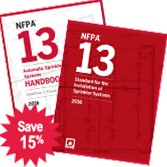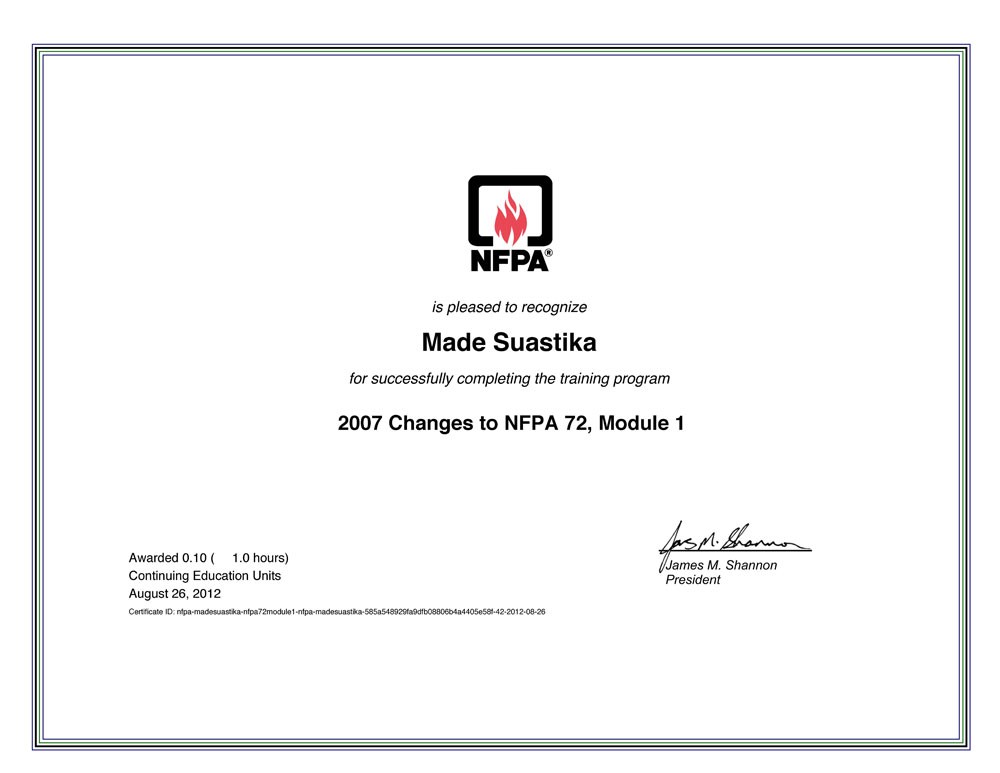Updates in the 2016 NFPA 13: Standard for the Installation of Sprinkler Systems help designers, engineers, contractors, and installers develop the best fire sprinkler defense for any occupancy. Fire protection challenges have changed along with construction materials and types of storage. Get equipped for today's hazards by getting up-to-code with the new industry standard for the automatic sprinkler system design, installation, and acceptance testing; hanging and bracing systems; underground piping; and seismic protection.
- Nfpa 13: Automatic Sprinkler Systems Handbook
Revisions to commodity classification tables in the 2016 NFPA 13 present the most significant update to the tables in over 30 years. Updated classification tables in Chapter 5 Annex based on today's materials help sprinkler system designers avoid common errors in classifying commodities. The new tables improve accuracy and reduce the risk for mistakes that could prove catastrophic in a fire. A task group addressed the costly problem of corrosion in piping. In a major change that impacts installers, the 2016 NFPA 13 adds a new requirement that a single air vent be installed for each wet sprinkler system to help reduce potential corrosion activity due to trapped air.
A task group concluded that venting the trapped air in a wet system can decrease water delivery time, reduce alarm ring delay, reduce water flow alarm cyclic ringing, and reduce corrosion activity. Other changes provide more flexible options for sprinkler design:. A new protection scheme for exposed bay plastics in racks has been added to Chapter 17, in response to the potential for serious fires.

New language added to Chapter 8 based on studies done by the Fire Protection Research Foundation allows sprinklers to be omitted above certain cloud ceiling configurations. Conversions to metric have switched from an exact conversion into an approximate conversion to make the Standard more usable and cost effective on a global scale. A new provision requires listed window sprinklers to be used where glazing assemblies are used as an alternative to fire-resistance-rated construction. Revisions in Chapter 9 address the use of concrete anchors. An alternative storage protection scheme has been added for certain storage arrangements, similar to the Scheme A allowance in NFPA 30: Flammable and Combustible Liquids Code. Gain the edge in sprinkler protection to prevent fire deaths and property loss.

NFPA 13: Standard for the Installation of Sprinkler Systems advances how sprinkler system designers, installers, maintainers, and AHJs can safeguard people and property against fire. Improve automatic fire sprinkler effectiveness and avoid errors using the new research-based 2016 edition of NFPA 13: Installation of Sprinkler Systems. (Softbound, 488 pp., 2016) Interested in previous editions of NFPA 13? NFPA 13: Installation of Sprinkler Systems helps reduce risks and fire loss with proven fire protection strategies.
Long considered the benchmark for automatic fire sprinkler systems, NFPA 13 presents consensus-based requirements for sprinkler system design approaches, installation, and component options. Compliance is essential to sprinkler performance, which in turn significantly reduces the risks of fire deaths and property loss. Each new edition of NFPA 13 reflects added knowledge about sprinkler performance under fire conditions. Changes are based on scientific research and a wide body of industry experience.
The 2010 NFPA 13: Installation of Sprinkler Systems is revised and updated with added criteria based on recent fire testing and studies performed by the Fire Protection Research Foundation. Chapter 20: Special Designs of Storage Protection presents requirements for the protection of three new special storage arrangements, including carton records storage with catwalk access, and high bay records storage. This edition also adopts the SEI/ASCE 7 approach for load calculations and introduces new zone-of-influence tables for Schedule 5 steel pipe, CPVC, and Type M copper tube. An important new method to calculate rack shelf area takes the placement of loads into consideration. The 2007 NFPA 13: Installation of Sprinkler Systems broadens coverage to support innovative technology and Chapter 11: Design Approaches clarifies design options. In a major change, eight new chapters in this edition address storage of specific commodities. Requirements for hanging and bracing meet or exceed the seismic requirements of ASCE 7: Minimum Design Loads for Buildings and Other Structures, and rules for sprinklers in combination with draft stops around vertical openings correlate with the 2006 edition of NFPA 101®: Life Safety Code®.

In another important revision, installation rules for residential sprinklers incorporate new research into system effectiveness, specifically with regard to obstructions such as ceiling fans and kitchen cabinets. The 2002 NFPA 13: Installation of Sprinkler Systems improves access to information by consolidating storage design requirements and approaches into Chapter 12: General Requirements for Storage.
For convenient referencing, you'll find extracts of sprinkler system requirements from more than 30 NFPA® codes and standards in a new chapter entitled Special Occupancy Requirements. In addition, all applicable provisions for underground piping - including materials, installation, and acceptance testing - are presented in Chapter 10, which coordinates with NFPA 24: Standard for the Installation of Private Fire Service Mains and Their Appurtenances. Expanded tables for Early Suppression Fast Response (ESFR) sprinklers allow you to choose the storage and building height for any arrangement. The 1999 NFPA 13: Installation of Sprinkler Systems presents a groundbreaking amount of new information about the proper design and installation of sprinkler systems. Double the size of previous editions, it includes portions of text from storage documents such as NFPA 231: Standard for General Storage and NFPA 231C: Standard for Rack Storage of Materials, along with extracts of or references to sprinkler requirements from documents throughout the NFPA system, including NFPA 99: Standard for Health Care Facilities and NFPA 101: Life Safety Code. Scores of important changes in this landmark edition include specifically identified criteria for special occupancy hazards, new minimum sizes for sprinklers used in storage applications, and a new separation requirement between ESFR and other sprinkler types. Interested in other editions of NFPA 13?
Use the drop down menu above to select the edition year you need. Gain fast access to the latest sprinkler provisions with Tabs for your NFPA 13 or Automatic Sprinkler Systems Handbook! Use these easy-to-apply self-adhesive Tabs to customize your copy of the new NFPA 13: Standard for Installation of Sprinkler Systems or its companion full-color Handbook. In the field or at your desk, Tabs help you pinpoint information instantly, to minimize the time you spend searching for information. Put the latest sprinkler requirements or expert advice at your fingertips!
(Set of 36) Please note that the 2016 NFPA 13 Tabs could be used in the 2013 edition instead. NFPA® eBooks and PDFs can be downloaded immediately after purchase for quick, easy access. For the best reading experience, NFPA recommends using the free NFPA eReader application, NFPA eLibrary. Download now. About the free NFPA eLibrary app The free NFPA eLibrary app gives you access to your NFPA eBooks and PDFs both online and offline. The app has tools to help you get your job done, search, highlight text, add bookmarks, or copy and paste text into your documents and presentations.
Sign-in with your NFPA username and password. Access is immediate. Accessing Upon purchase of an NFPA eBook or PDF, you will be prompted with instructions for downloading and accessing.
This standard provides a range of sprinkler system approaches, design development alternatives, and component options that are all acceptable. Building owners and their designated representatives are advised to carefully evaluate proposed selections for appropriateness and preference. This standard shall provide the minimum requirements for the design and installation of automatic fire sprinkler systems and exposure protection sprinkler systems covered within this standard. This standard shall not provide requirements for the design or installation of water mist fire protection systems, which are not considered fire sprinkler systems and are addressed by NFPA 750. This standard is written with the assumption that the sprinkler system shall be designed to protect against a single fire originating within the building. This standard also provides guidance for the installation of systems for exterior protection and specific hazards. Where these systems are installed, they are also designed for protection of a fire from a single ignition source.
Purpose Since its inception, this document has been developed on the basis of standardized materials, devices, and design practices. However, Section 1.2 and other subsections such as 6.3.7.8 and 8.4.8 allow the use of materials and devices not specifically designated by this standard, provided such use is within parameters established by a listing organization. In using such materials or devices, it is important that all conditions, requirements, and limitations of the listing be fully understood and accepted and that the installation be in complete accord with such listing requirements.
The purpose of this standard shall be to provide a reasonable degree of protection for life and property from fire through standardization of design, installation, and testing requirements for sprinkler systems, including private fire service mains, based on sound engineering principles, test data, and field experience. Update to the 2013 NFPA 13 for more design options and greater usability: Modified Chapter 16 and Chapter 17 combine in-rack and ceiling sprinkler requirements in the same section to streamline referencing and help you maximize your time. New Chapter 21 on alternative storage approaches facilitates use of performance-based design - especially for sprinkler systems designed around a specific commodity or storage arrangement. New requirements concerning nonmetallic piping help contractors, owners, and manufacturers recognize and address material compatibility issues, before oversights occur. New provisions allowing the backflow preventer to serve as a system control valve Updated requirements for elevators The latest coverage on antifreeze, heat tracing and heat loss calculations.
Nfpa 13: Automatic Sprinkler Systems Handbook
Written by sprinkler industry leaders and redesigned for greater usability, the 2016 NFPA 13 Handbook helps you implement the new industry standard. To accompany the milestone 2016 NFPA 13, NFPA® presents the fully redesigned new Automatic Sprinkler Systems Handbook. Current with the 2016 NFPA 13: Standard for the Installation of Sprinkler Systems and the latest sprinkler technology, the Handbook helps you apply scientifically-based solutions that reduce risks and fire loss. Written by the foremost experts in fire sprinkler engineering, fire testing, and applications, this full-color resource is packed with expertise, color visuals, and information that prepares you to conduct accurate and efficient system design, installation, and testing.
Get equipped with essential know-how and support! Here's how the NFPA 13 Handbook assists designers, engineers, contractors, and installers on the job:. Complete 2016 NFPA 13 text brings you up-to-code with the latest research-based requirements for system design, installation, and acceptance testing. Exclusive commentary explaining the intent behind provisions is written by leading industry experts, including Wes Baker, Tracey Bellamy, Bob Caputo, John Denhardt, John Deutsch, Jim Biggins, Roland Huggins, and Pete Schwab. Hundreds of full-color photos, graphics, and detailed illustrations clarify concepts. New artwork provides a detailed look at the starting and stopping points of several NFPA systems including underground mains (NFPA 24) storage tanks (NFPA 22), fixed water spray systems (NFPA 15), fire pumps (NFPA 20), fire sprinklers (NFPA 13), and standpipes (NFPA 14). Expanded checklists and worksheets include a new plans review feature from the AHJ perspective written by David Lowrey.
NFPA 13 Lessons at the back of some chapters include new storage lessons by James Golinveaux, and hanging and bracing lessons by John Deutsch. Project workflow diagrams and flowcharts illustrate the progress of a sprinkler project step-by-step. Decision trees on protection for storage shows users how to choose the right sprinkler strategy for any facility. Supplements address the European Experience wtih Fire Sprinklers; an overview of technical changes from the 2013 and 2016 editions of NFPA 13; the Evolution of Storage Sprinkler Standards; and Step-by-Step Hydraulic Calculations for a Fire Sprinkler System. New design features improve navigation and make information more accessible. Ask the AHJ FAQs help installers avoid common errors.
Designer's Corner features take a deep dive into design topics. Updated line art improves your understanding of connections. Historical Note feature reviews some of the background behind material in the handbook. Research Note feature spotlights material based on research in the field. Closer Look feature provides further information on specific subjects or issues.
FPRF Spotlight covers research by the Fire Protection Research Foundation directly impacting NFPA 13 code changes for 2016.
Posted by: sabinasamicke0194875.blogspot.com
Source: https://rewardsheavy.weebly.com/nfpa-13-automatic-sprinkler-systems-handbook-pdf.html
Post a Comment